Pathway to Australian Permanent Residency for Engineers
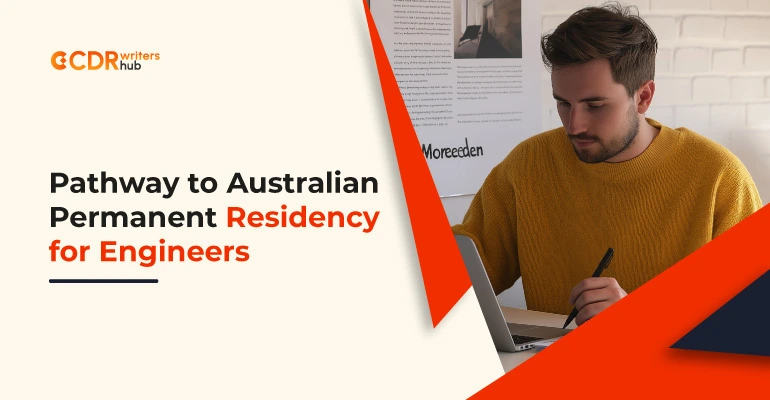
Pathway to Australian Permanent Residency for Engineers
Australia is a dream destination for experts worldwide, offering a balanced lifestyle, high living standards, and limitless opportunities for professional development. For engineers, the country holds even greater appeal due to its powerful infrastructure, innovative projects, and an ever-growing demand for skilled workers in this field.
For engineers who want to call Australia home, permanent residency (PR) is the ultimate goal. Securing PR status offers not only the freedom to live and work indefinitely but also access to numerous benefits, including healthcare, education, and the possibility of becoming an Australian citizen.
This article provides a detailed pathway for engineers desiring to secure Australian Permanent Residency (PR), detailing the steps involved, the challenges to predict, and how to navigate the process successfully.
What are the pathways to Australian Permanent Residency for Engineers?
Table of Contents
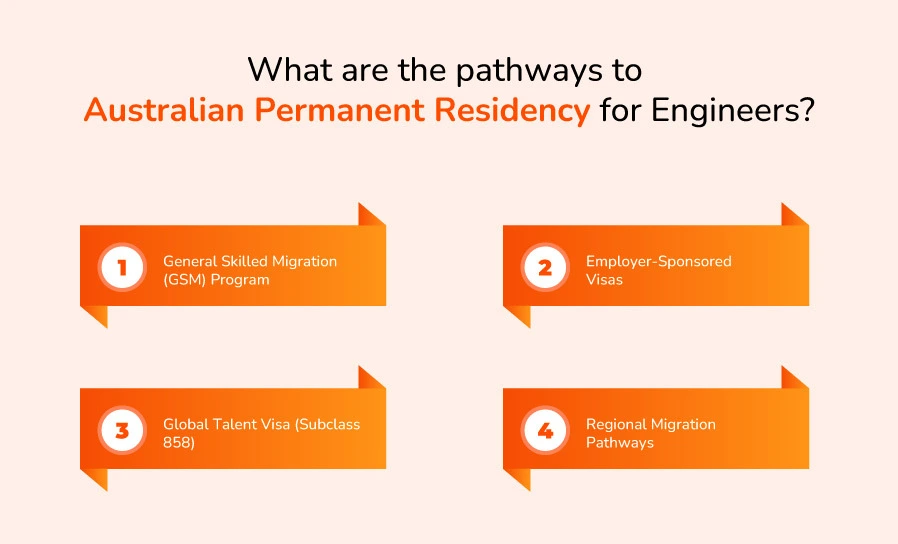 Australia’s immigration system is designed to attract skilled workers, including engineers, through various visa options. Engineers have multiple pathways to secure a permanent residency (PR), with their respective pathways offering unique benefits depending on qualifications, work experience, and the type of work they intend to pursue in Australia.
Australia’s immigration system is designed to attract skilled workers, including engineers, through various visa options. Engineers have multiple pathways to secure a permanent residency (PR), with their respective pathways offering unique benefits depending on qualifications, work experience, and the type of work they intend to pursue in Australia.
Below is an extended explanation of the most common pathways available to engineers aiming to secure Australian PR.
1. General Skilled Migration (GSM) Program
The General Skilled Migration (GSM) programme is the most popular and widely used pathway for engineers to gain permanent residency in Australia. It is a points-based system where applicants are awarded points based on age, English proficiency, work experience, and education.
The higher your points, the greater your chances of receiving an invitation for permanent residency. Engineers can apply through various visa subclasses within the GSM programme.
Eligibility Criteria for GSM Visas
a. Skills Assessment
Engineers must have their qualifications evaluated by Engineers Australia, the designated assessing authority.
b. Occupation in Demand
The applicant’s occupation should be on the Medium and Long-term Strategic Skills List (MLTSSL) or the Regional Occupation List (ROL).
c. Point Requirement
Points are awarded based on age, English proficiency, work experience, education, and other criteria. A minimum of 65 points is required, though higher scores improve chances.
d. Expression of Interest (EOI)
Applicants must lodge an EOI through SkillsSelect.
2. Employer-Sponsored Visas
If you have a job offer from an Australian employer, employer-sponsored visas offer another pathway to Australian PR. Sponsoring employers enables skilled workers to live and work in Australia through these visas. Once you have held temporary employer-sponsored visas for a certain period, you can apply for PR.
Eligibility Requirements
- An Australian employer must nominate you for a position that requires your skills and qualifications.
- The job must be full-time and ongoing.
- You must be under 45 years of age.
- You must have at least three years of appropriate work experience.
- You must have a positive skills assessment.
- You need to meet the required level of English proficiency.
3. Global Talent Visa (Subclass 858)
The Global Talent Visa is a fast-track PR option for highly skilled professionals, including engineers, with expertise in cutting-edge fields such as artificial intelligence, robotics, renewable energy, and advanced manufacturing. This visa is designed to attract the best talent to Australia to work on important projects that will shape the country’s future.
Eligibility Requirements:
- You must have exceptional skills in one of the identified target sectors, such as engineering (particularly emerging technologies).
- You should demonstrate that you are internationally recognised as an expert in your field.
- A recognised Australian or an individual with expertise in your area must nominate you.
4. Regional Migration Pathways
Australia wants to encourage migration to regions with greater skill shortages. Engineers open to living and working in these regions may benefit from special programmes offering incentives such as additional points, priority processing, and longer temporary stay allowances.
Learn more: How to achieve maximum points by engineers to be eligible for the PR visa🤔🌏✈️
Steps to Apply for Australian PR as an Engineer
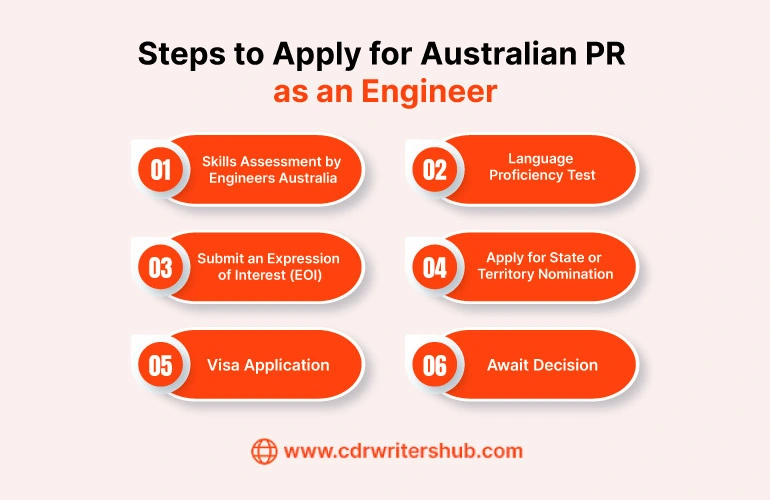
Applying for an Australian Permanent Residency (PR) as an engineer involves multiple steps that require attention to detail, preparation, and careful execution. The guide below will help you navigate the process effectively.
Step 1:
Skills Assessment by Engineers Australia
Engineers Australia (EA) is the specified authority in charge of assessing engineers’ qualifications and work experience for Australian immigration. Completing this step is critical, as it validates that your engineering skills meet Australian standards.
1. Choose the Right Assessment Pathway
a. Accredited Qualifications Pathway
If your degree is accredited under international agreements like the Washington, Sydney, or Dublin Accords, this is the fastest pathway. For example, if you earned your degree from an accredited institution in the USA, UK, or another participating country, you qualify for this pathway.
b. Competency Demonstration Report (CDR) Pathway
If your degree is not accredited, you must prepare a CDR, which involves showcasing your engineering competencies through a detailed report.
2. Prepare Your Competency Demonstration Report (CDR)
a. Curriculum Vitae (CV)
Include a detailed CV outlining your engineering roles, responsibilities, and achievements.
b. Three Career Episodes
Write three narratives about specific engineering projects or tasks you handled. Focus on demonstrating your problem-solving abilities, technical skills, and independent contributions.
c. Summary Statement
Summarise how your career episodes align with Engineers Australia’s competency standards.
d. Continuing Professional Development (CPD)
Provide evidence of training, certifications, or learning activities you undertook to enhance your engineering knowledge.
3. Submit Required Documents
- Make certified copies of your academic transcripts and degree certificates.
- Proof of work experience, such as employment contracts and reference letters.
- Evidence of English proficiency
4. Pay the Fees and Await Outcome
Engineers Australia assesses your application, typically taking 4–8 weeks. A positive assessment is mandatory to proceed to the next stage.
Step 2:
Language Proficiency Test
English proficiency is a critical requirement for Australian PR. You must demonstrate your ability to read, write, listen, and speak English by taking an accepted language test. The higher your score, the more points you will receive in the PR points test.
- Choose an approved English test
a. IELTS
General or Academic module with minimum scores of 6 in each band for eligibility. Scores above 7 or 8 earn additional points.
b. PTE Academic
Minimum scores of 50 in each section; higher scores provide bonus points.
c. TOEFL iBT
Accepted with equivalent scores to IELTS.
d. Cambridge Advanced English (CAE)
Scores aligned with Australian PR eligibility.
- Prepare and Take the Test
Study and practice using official materials or join coaching classes if needed.
Schedule the test in advance and aim for higher scores to improve your chances.
- Submit Test Results
Upload your test scores to the SkillSelect portal during your EOI submission.
Step 3
Submit an Expression of Interest (EOI)
The Expression of Interest (EOI) is a critically important step in the PR process. Through this step, you inform the Australian government about your skills, qualifications, and intention to apply for PR.
1. Create an Account on SkillSelect
Register on the Department of Home Affairs’ SkillSelect platform.
Complete your profile by entering your occupation, skills assessment outcome, English test scores, and employment history.
2. Select the appropriate visa subclass.
Choose from Subclass 189 (Skilled Independent Visa), Subclass 190 (Skilled Nominated Visa), or Subclass 491 (Skilled Work Regional Visa), depending on your eligibility and preferences.
3. Accurately Enter Your Points
Calculate your total points based on age, English proficiency, work experience, education, and other factors.
Points above 65 improve your chances of receiving an invitation.
4. Submit Your EOI
After completing your profile, submit your EOI. You will receive a rank in the SkillSelect pool based on your score on points.
Step 4
Apply for State or Territory Nomination
If you apply for a Subclass 190 or Subclass 491 visa, you must obtain a proposal from a state or territory government.
1. Research State Requirements
Each state has a list of occupations in demand and specific nomination criteria. For example, Western Australia might prioritise civil engineers, while South Australia may focus on renewable energy engineers.
Ensure your engineering occupation is listed on the state’s demand list.
2. Submit Your Application
Apply for state nomination through the respective state’s immigration website.
Provide supporting documents, such as proof of state residency or a job offer.
3. Await nomination approval
States or territories evaluate your application and approve nominations based on labour market needs.
Step 5
Visa Application
Once you receive an invitation to apply (ITA) based on your EOI, you can submit your visa application.
1. Prepare Documents
a. Skills Assessment
Include your positive outcome from Engineers Australia.
b. English Proficiency Test
Attach your test results.
c. Work Experience Letter
Provide employer reference letters detailing your roles and responsibilities.
d. Academic transcripts
Submit certified copies of your educational qualifications.
e. Police Clearance Certificates
Obtain certificates from countries where you have lived for 12 months or more in the last 10 years.
2. Submit the Visa Application
Install your application through the Department of Home Affairs online portal.
Pay the visa application fee, which varies by visa subclass.
3. Wait for Processing
Processing times vary by visa subclass, ranging from a few months to a year.
Step 6
Await Decision
After submitting your application, the Department of Home Affairs reviews your documents, verifies your credentials, and evaluates your eligibility.
1. Respond to Additional Requests
If the department requires further information, respond promptly.
Attend medical examinations or provide additional evidence, if requested.
2. Receive Visa Approval
When your application is approved, you will receive a visa grant notice. For PR visas, this allows you to live, work, and study in Australia indefinitely.
What are the best practices for a successful PR application?
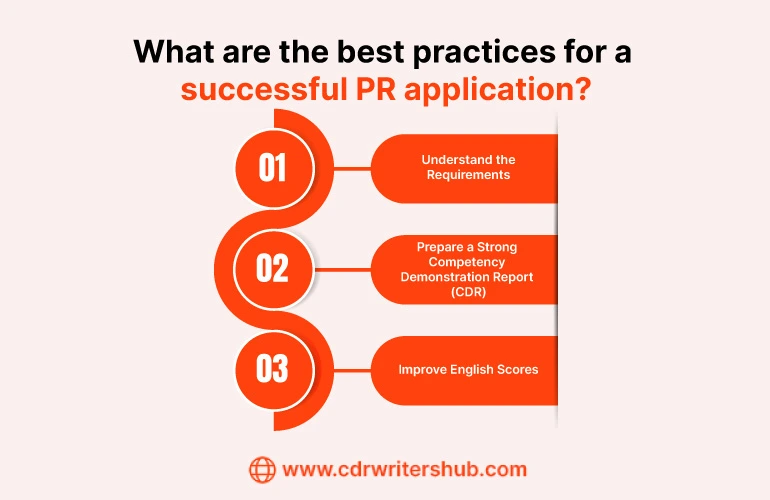
Securing Permanent Residency (PR) as an engineer in Australia requires not only meeting the technical and documentation requirements but also strategic planning and execution.
Below are detailed tips to enhance your chances of success throughout the PR application process.
1. Understand the Requirements
Each visa subclass under the General Skilled Migration (GSM) programme and employer-sponsored pathways has distinct eligibility Failure to meet even one requirement can result in rejection. To ensure success:
- Research Your Visa Options: Familiarise yourself with visa subclasses such as Subclass 189 (Skilled Independent), Subclass 190 (Skilled Nominated), or Subclass 491 (Skilled Regional Provisional). Understand which one aligns with your profile and goals.
- Review State/Territory Occupation Lists: If applying for Subclass 190 or 491, check specific occupation lists and additional requirements for each state or territory.
- Stay Informed: Immigration laws and policies frequently change. To stay accurate to date on rule changes, subscribe to updates from the Australian Department of Home Affairs or consult trusted migration resources.
2. Prepare a Strong Competency Demonstration Report (CDR)
For engineers whose qualifications are not accredited under international agreements (e.g., Washington Accord), the Competency Demonstration Report (CDR) is a critical element of the application. Your CDR reflects your technical skills, problem-solving abilities, and contribution to engineering projects.
- Career Episodes
Write three career episodes detailing distinct projects or tasks you managed or contributed to. Each episode should highlight:
- Your role and responsibilities.
- Challenges faced and how you addressed them.
- Outcomes of your work and how it benefited the project.
- Example: If you worked on a construction project, detail how you designed an efficient drainage system that reduced costs and improved sustainability.
- Summary Statement
Link your career episodes to the competency standards defined by Engineers Australia. Be clear and concise about how you meet the required standards.
- Continuing Professional Development (CPD)
Continuing Professional Development (CPD) showcases ongoing efforts to keep your skills updated, such as attending workshops, pursuing certifications, or engaging in technical research.
3. Improve English Scores
English language proficiency plays a dual role in your PR application: it determines eligibility and contributes significantly to your points score. Achieving higher scores can elevate your application’s rank in the SkillSelect pool.
- Aim for Superior English: Scoring at the “Superior” level in tests like IELTS (8+ in each band) or PTE Academic (79+ in each section) earns you the maximum points (20).
- Practice Regularly: Dedicate time to practice reading, writing, listening, and speaking. Use mock tests, apps, or coaching services to refine your skills.
- Know the Test Format: Each English test has unique patterns. Familiarise yourself with the format of your chosen test to avoid surprises on exam day.
Challenges of Getting Australian PR for Engineers
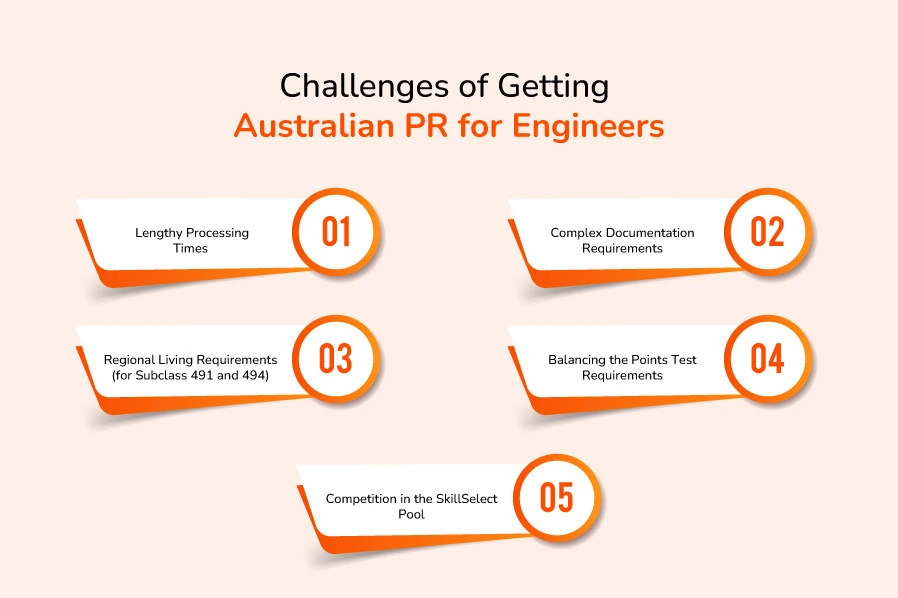
While Australia offers attractive opportunities for engineers, the process of obtaining a permanent residency (PR) can present several challenges. Being aware of these potential obstacles and preparing for them in advance will help you navigate the journey smoothly.
Below, we explore these challenges in greater detail and offer solutions to manage them effectively.
1. Lengthy Processing Times
The visa application process for Australian PR, particularly under skilled migration pathways, can take several months or even years to complete. Delays may occur due to high application volumes, errors in submitted documentation, or additional verification requirements.
a. Average Processing Times
Skilled visas such as Subclass 189, 190, and 491 typically take anywhere from 6 months to over a year to process, depending on factors like occupation demand and workload at the Department of Home Affairs.
b. COVID-19 Backlog
Recent years have seen backlogs caused by pandemic-related disruptions, further extending wait times.
c. Additional Assessments
Some applicants face delays due to requests for more documentation, additional background checks, or health and character assessments.
How to Overcome This Challenge
a. Submit a complete and accurate application
Double-check all documents for errors or omissions to avoid delays caused by requests for additional information.
b. Monitor Processing Times
Stay informed about average visa processing times for your chosen subclass through the Department of Home Affairs official website.
Plan Financially: Since PR processing can take a long time, plan your finances to cover living expenses or temporary visa renewals during the waiting period.
2. Complex Documentation Requirements
Preparing and submitting accurate documentation is critical for PR applications. Errors, omissions, or inconsistencies in your documents can lead to delays or even rejection.
a. Skills Assessment
Engineers Australia requires detailed and specific documents such as academic transcripts, employment reference letters, and competency demonstration reports (CDR). Failing to meet their guidelines can lead to rejection.
b. Visa Application
Documents like proof of identity, police clearance certificates, and health records must meet strict standards.
c. State/Territory Nomination
States often request additional documentation, such as evidence of residence or a job offer within their jurisdiction.
How to Overcome This Challenge
a. Create a document Checklist
List all required documents for your skills assessment, EOI, and visa application, and organise them systematically.
b. Get Professional Help
If in doubt, seek assistance from a migration agent or consultant who can ensure your documentation meets Australian standards.
c. Translate Documents
If your documents are not in English, have them translated by a certified translator before submission.
3. Regional Living Requirements (for Subclass 491 and 494)
If you choose a regional pathway, such as Subclass 491 (Skilled Work Regional Visa) or Subclass 494 (Employer Sponsored Regional Visa), you must live and work in specific regional areas. This is required for a set period, typically three years, before applying for permanent residency.
a. Regional Areas
Except for Sydney, Melbourne, and Brisbane, regional areas cover the entire country of Australia. Some regional cities like Adelaide and Perth still offer modern amenities, but others might be more remote.
b. Work Availability
Finding jobs in smaller regional towns can be challenging, especially if your engineering specialisation has limited demand in that area.
c. Adaptation to Regional Life
Living in a regional area may require adjustments, such as coping with fewer public transport options, limited entertainment facilities, or distance from major cities.
How to Overcome This Challenge
a. Research Regional Areas
Choose regions aligned with your engineering field. For example, mining engineers might find more opportunities in Western Australia or Queensland, while civil engineers may thrive in regional Victoria.
b. Seek Employment Early
Begin applying for regional jobs before arriving in Australia to secure employment faster.
c. Leverage Regional Incentives
Regional areas often offer additional support for migrants, such as housing subsidies or networking opportunities to integrate into the community.
4. Balancing the Points Test Requirements
Meeting the minimum 65 points for skilled migration eligibility can be challenging, especially if you have fewer years of work experience, are older, or lack additional qualifications.
a. Age Factor
Points decrease significantly as you get older, particularly after 40.
b. English Proficiency
Achieving higher scores (e.g., “superior English”) requires strong preparation and practice.
c. Work Experience Evidence
Claiming points for overseas or Australian work experience requires detailed proof, such as reference letters and payslips, which can be difficult to obtain.
How to Overcome This Challenge
a. Boost Your Points
Participate in programmes like the Professional Year for Engineers, which adds 5 points to your total score.
b. Focus on English Proficiency
Aim for “superior” scores in English tests like IELTS or PTE, which can contribute up to 20 points.
c. Secure a State/Territory Nomination
Gaining a nomination under Subclass 190 (5 points) or Subclass 491 (15 points) can significantly enhance your total.
5. Competition in the SkillSelect Pool
Skilled migration operates on a competitive ranking system. Even if you meet the minimum eligibility criteria, you may not receive an invitation if other candidates have higher points or more in-demand skills.
a. EOI Ranking System
Expressions of Interest (EOI) are ranked based on total points, with invitations issued to the highest-scoring candidates.
b. Demand for Engineers
While engineers are generally in demand, specific occupations (e.g., civil vs. software engineers) may vary in priority, affecting the likelihood of receiving an invitation.
c. Limited Invitations
The Australian government issues a fixed number of invitations per round, increasing competition among applicants.
How to Overcome This Challenge
a. Maximise Points
Use all available strategies to improve your points score (e.g., state nominations, spouse skills, or additional qualifications).
b. Target Regional Pathways
Regional visas often have less competition and higher chances of success.
c. Stay Flexible
If you don’t receive an invitation within a reasonable time, consider alternative options, such as employer sponsorship.
Know more: What should you do if your Australian visa expiration date is nearing?😕🤷👈
Conclusion
The journey to obtaining an Australian Permanent Residency as an engineer is undoubtedly challenging but highly rewarding. With Australia’s strong demand for skilled engineers, transparent immigration policies, and diverse visa pathways, professionals in this field have a significant advantage.
Success in this endeavour requires meticulous preparation, strategic planning, and an unwavering commitment to your goals. By understanding the visa requirements, optimising your points, and utilising pathways like general skilled migration, employer sponsorship, or regional opportunities, you can navigate the process confidently.
Remember that persistence and attention to detail are your most valuable assets. Seek professional guidance when needed and stay informed about evolving immigration policies to adapt effectively.
Achieving PR in Australia isn’t just about meeting immigration criteria; it’s about embracing a future filled with opportunities for career growth, stability, and a high quality of life. As an engineer, you hold the skills and expertise that Australia values immensely. And your determination can turn the dream of Australian residency into a reality.
Start your journey today, and take one step closer to building a fulfilling life in one of the world’s most prosperous and welcoming nations.
FAQs
1. Can engineers get PR in Australia?
Yes, engineers can get PR in Australia as they are in demand and eligible for skilled visas like Subclass 189, 190, or 491, provided they meet the requirements.
2. Which engineering course is best for PR in Australia?
The best engineering courses for PR in Australia are typically those related to high-demand fields, such as:
Civil Engineering
- Mechanical Engineering
- Electrical Engineering
- Software Engineering
- Structural Engineering
3. What is the required IELTS score for engineers in Australia?
The required IELTS score for engineers in Australia is usually 6.0 in each band, though a score of 7.0 or higher is preferred for better PR chances.
4. Is there a demand for engineers in Australia?
Yes, Australia has a strong demand for engineers, especially in civil, mechanical, electrical, software, and mining engineering.
5. Why is Australia experiencing an engineer shortage?
Rapid infrastructure growth, technological advances, an ageing workforce, and a gap between demand and the number of engineering graduates cause the shortage of engineers in Australia.



